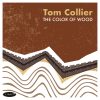This past April, percussionist Tom Collier released his new album, The Color of Woodthrough Summit Records. His first studio recording since the release of his 2017 album, Impulsive Illumination, it is a unique addition to this year’s field of new jazz and overall albums. That is because the 15-song record defies classification, as is evidenced through its multitude of arrangements. This will be discussed shortly. While that diversity of sounds and styles forms a solid foundation for the album, the lack of any background on the songs in the liner notes detracts from the record’s presentation to a point. This will be discussed a little later. The record’s production works with the arrangements to make for even more appeal and will be discussed later, too. Each item noted is important in its own way to the whole of the record’s presentation. All things considered they make The Color of Wood one of the most unique overall records to be released so far this year that will appeal to every percussionist out there.
The Color of Wood, percussionist Tom Collier’s latest album is another unique record from the veteran musician. It is a presentation that really defies any real classification from beginning to end. It is not a jazz album, despite being released through a jazz label. It is not necessarily a modern classical work and nor is it even just purely some artsy type of record. It is a presentation that in reality…is a percussionist’s record, point blank. It is just Collier alone on marimba from beginning to end. At times it is clear that his performances are likely layered, because there is no way that he could have done some of the things in some of the faster arrangements completely by himself all at once, even using a traditional grip, holding multiple mallets. This is a rare approach in comparison to the music in his existing catalog. He has done more funky stuff in one album, worked with other musicians in others, etc. So, to have this record feature just Collier performing a group of unique arrangements (including a pair of covers) is something interesting, as are the arrangements themselves.
Speaking of the arrangements, the aptly titled ‘Five Reflections on Wood’ apparently is one of those standout compositions. It was inspired by a group of painters – Ruthi Winter, Cindy Kelsey, Jim and Mary Burdett, and Adelle Hermann Comfort – and by his wife, Cheryl according to the very brief information in the liner notes. Obviously only certain people are likely to know who the noted painters are along with their paintings. At the same time though, not knowing them or their works could lead those other audiences to research them. It could lead to a whole new discovery and appreciation for those artists. The arrangements that were inspired by the noted artists are so strong in their approaches. From one to the next, Collier shows his ability to perform fast, intricate rhythmic patterns just as well as more subdued, contemplative works. The very first movement, ‘Portrait of Cheryl’ (which was the piece inspired by his wife) is one of the movements that shows his ability to handle more upbeat works expertly. He works his way up and down the marimba with so much ease, controlling the dynamics so well. ‘A Sister’s Radiant Painting’ finds Collier moving in a much more subdued fashion, using so much control, including in his dynamic control. The subtleties used throughout the song make it so immersive and its transition in to the opus’ third movement, ‘Portrait of a Scarlet Flower’ is seamless. This is just as certain to keep listeners engaged, as that composition is just as relaxed and subdued. As the composition progresses into its fourth and fifth movements, he continues to put his talents on full display just as much in the equally interesting arrangements, ‘Shelling at Horsehead Bay’ and ‘Ode to a Sunset.’ ‘Ode to a Sunset’ is such a positive yet relaxed composition that even without liner notes, really does paint its own musical picture, that of someone sitting in the warm weather, watching the sun set over a given situation. The whole of the song is such a pleasing, appealing work. It is just one of the works that makes the record unique. Collier’s take of Hank Williams Sr.’s ‘I’m So Lonesome, I Could Cry’ is another presentation that shows the importance of the album’s musical content.
Collier’s cover of ‘I’m So Lonesome, I Could Cry’ is anything but that original composition. Collier gives the song a completely new identity in its presentation here. Instead of the melancholy song of lost love that everyone knows, Collier paints a picture that is more bluesy and upbeat. The chromatic scales that he uses as part of the arrangement and the occasional bluesy runs give the song such an intriguing approach and sound. It really is something that must be heard firsthand to be fully understood and appreciated. Simply put, it is a cover, but in its originality, is original in its own right. It is just one more example of why the record’s musical content is so important to its presentation. ‘The Owls Seem What They Want’ is yet another clear example of what makes the albums’ content so enjoyable.
‘The Owls Seem What They Want’ opens with Collier echoing the sounds of owls calling in the air by using a simple, steady beat on the marimba’s lower end. He maintains the “call” throughout the composition as its base as he then gets slightly more active in the song’s main body. The more energetic side of the song conjures thoughts of, maybe, owls in flight in the forest, all the while that call of the birds serving as the song’s foundation. It is one more unique, fully immersive addition to the album that shows the record’s strength. When it and the other songs examined here are considered alongside the rest of the record’s works, the whole makes for so much musical appeal.
As much as the record’s musical arrangements do to make this album engaging and entertaining, the record is not perfect. The lack of any real substantive background on the songs detracts from the record to a point. Yes, there is a slight background on ‘Five Reflections on Wood.’ The thing of it though, is that said background is minimal at best. All that Collier notes is that the composition was inspired by his wife and by a group of painters of whom most audiences likely do not know. Other than that, there really is no background on any of the songs. To that end, it detracts from the record to a point. It is not enough to doom the record but does detract from the record’s presentation enough to be something of a concern.
Getting back to the positive, the record’s production works with the arrangements to make for its own appeal. As noted, the arrangements show a wide range of sounds and styles from one to the next. From more energetic works to more subdued compositions, Collier gives audiences much to appreciate. Because of that diversity, plenty of attention had to have been paid to the production so as to bring out the best of each opus. That work and attention paid off, too. That is because it results in each song presenting such a positive general effect. The overall general effect works with the arrangements to make the album’s overall aesthetic so appealing that percussionists and music lovers in general will find themselves taking in this record time and again.
The Color of Wood, Tom Collier’s latest studio album, is an impressive new offering from the veteran percussionist. It is a presentation that will appeal just as much to percussionists as it will to any music lover in general. That is evidenced in part through its featured musical arrangements. The arrangements are diverse in their sound and style. The control that Collier shows throughout the album is impressive to say the very least, adding to the songs’ appeal. As much as the album’s main content does to make it appealing, the lack of any background on the songs in the liner notes detracts from the record’s presentation. It is not enough to doom the album, but still does take away from the overall listening experience. The songs’ production works with the arrangements to put one more accent to the presentation, as it brings out the best in each composition. When the production and arrangements are considered together, the aesthetic that they collectively create is just enough to make the album that much more worth hearing time and again. That is even with the lack of liner notes in mind. Each item examined is important in its own way to the whole of the album’s presentation. All things considered the album proves itself to be one of the year’s top new albums overall.











